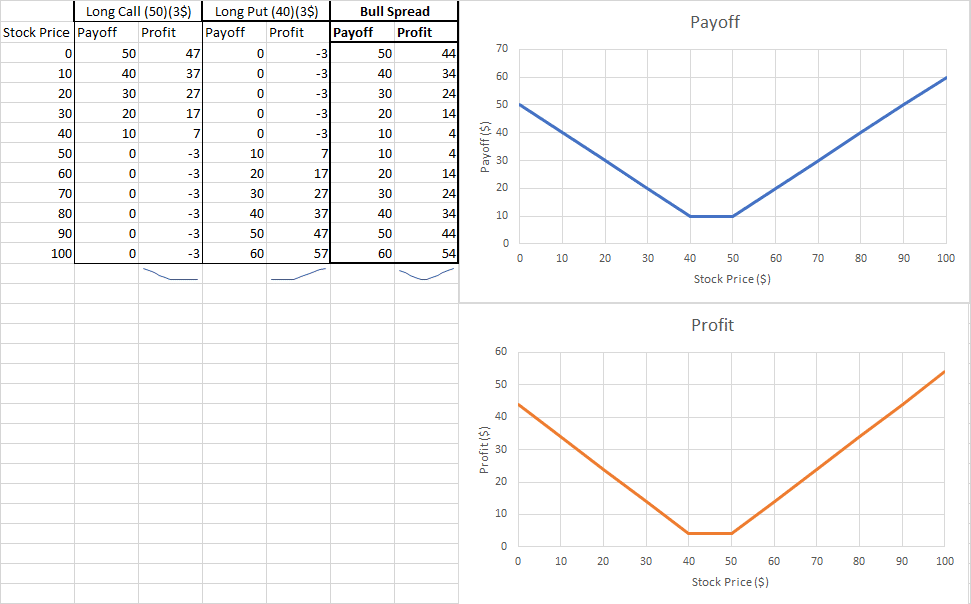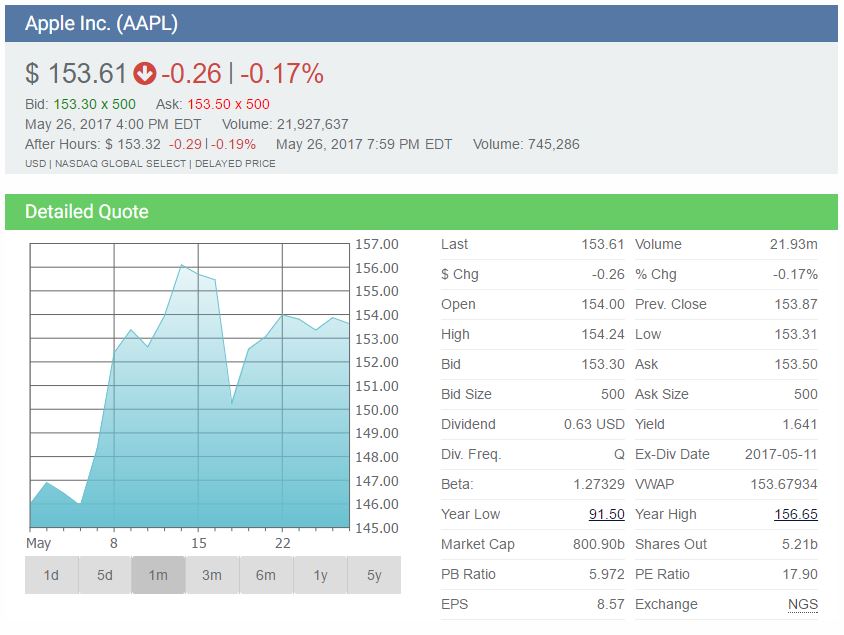A butterfly is a volatility bet that the trader can implement to protect against large fluctuations, or to gain on volatility.
A Strangle is a volatility bet where you simultaneously long a put at Strike Price 2 and long a put at Strike Price 1, betting the stock price will make a big movement in either direction. This is similar to a Straddle, but the trader shorts the stocks instead of buying them (but the profit is basically the same)
Straddles an option strategy that profits with volatility. You simultaneously buy long a call at Strike Price 1 and long a put at Strike Price 1. This creates a triangular shaped payoff and profit graph where the reward is based on the volatility of the stock – you’ll make a profit if the stock’s price makes a BIG move in either direction, but take a loss if it doesn’t move much.
A bullish collar is a protection strategy where you simultaneously buy a call at strike price 1 and sell a put at strike price 2. This strategy is for investors who has a bullish perception on the underlying asset. We can also create a “bearish” collar by simultaneously buying a put at strike price 1 and selling a call at strike price 2.
A ratio strategy is an option strategy that is created by having X amount of call options at Strike Price 1 and shorting Y amount of call options at Strike Price 2. This strategy is used when the investor thinks the price won’t move much, but they want to get a bigger profit based on a slight movement up or down.
A box spread is an option strategy that is created by combining the components of the bull spread and the bear spread. In theory, a box spread should always have a zero profit and zero loss, but some investors use them if they see that current options prices aren’t fully “priced in”. In many cases, the commissions charged for the trades needed for this spread will be greater than the profit.
A bear spread is a strategy where you simultaneously buy a call option at Strike Price 1 (some amount higher than the current market rate), and sell a call option at Strike Price 2 (some amount lower than the current market right). This is used if the trader thinks the price of the stock will go down, but not by much. It limits both the risk and reward.
A bull spread is a strategy where you simultaneously buy a long call at Strike Price 1, and sell a call for Strike Price 2 (some higher amount). Use this strategy if you think that a stock’s price will go up above your Point 1, but not as high as your Point 2.
A cap is an options protection strategy where you simultaneously have a short position on a stock and a long call for the same underlying asset. Adding a long call to your open position means that you have the right to cover your short at the strike price.
A floor is an options insurance strategy where you simultaneously have a long open position on a stock and a long put for the same underlying asset. Adding a long put to your open position means that if the stock’s price starts to fall, you still have the right to sell it off at the price specified by your option.
A covered put is an options insurance strategy where you simultaneously have a short open position on a stock and sell a put option for the same underlying option. This means you’re shorting a stock, but give someone else the right to sell you that stock at certain price in the future. You would use this if you were certain a stock’s price wasn’t going to go up, but you weren’t sure if would go down either – so you make a bit more money if the price doesn’t change.
A covered call is an options insurance strategy where you simultaneously own a stock and sell a call option for the same symbol (usually for a higher price than what you paid for it). This gives someone else the right (but not obligation) to buy your stock from you later at a specific price. If the underlying stock’s price goes up, the buyer will exercise the option and buy the shares. If the price goes down, the seller of the option keeps both the stocks and the price of the options.
A long call is a term used when you own a call option for an underlying asset. A call option is a contract where the buyer has the right (not the obligation) to exercise a buy transaction at a specific strike price at or before an expiration date. In the world of trading, owing a long call means that you have a contract that gives you the right to buy the underlying asset at a specific price, before a maturity date.
A short call is a term used when you sell a call option for an underlying asset. If you use this type of option, you’re selling someone else the right to buy a stock from you at a certain price in the future. If the stock’s price goes down, you keep the money you made by selling the option. If the stock’s price goes up, you are required to sell the stock at the agreed upon price, taking a loss.
A long put is a term used when you own a put option for an underlying asset. A put option is a contract where the buyer of the put has the right (not the obligation) to exercise a sell transaction at a specific strike price before an expiration date. In the world of trading, owning a long put means that you have a contract that gives you the right to sell the underlying asset at a specific price, before a maturity date.
A “short put” is selling a put option on an underlying asset. Short Puts are used by an investor who thinks a stock’s price is not going to go down. For example, with this type of trade, you would sell a Put option to someone else – giving them the right to sell a stock to you at the price you agreed on. If the price of that stock goes above that price, you keep the price of the option. If the price goes down, you’ll be required to buy the underlying stock at the Put price.
Stock and bond prices move up and down every day – sometimes by very large amounts. Movement comes primarily from supply and demand of shares – which in turn is largely driven by information and how investors perceive the companies in the markets.
Future Options are exactly what their name implies – an option on a futures contract.
Read this article for three crucial futures trading tips!
Includes industries, currencies, metals, interest rates/bonds, grains/oil seeds, food/fibers, and livestocks!
Calendar includes grains, metals, currencies, energies, financials, meats, softs and indices.
Option strategies allow you select any number of pros and cons depending on your strategy, that cannot be done with simply owning or shorting the stock. Read this article for more details on option strategies!
A straddle is an investment strategy that involves the purchase or sale of an option allowing the investor to profit regardless of the direction of movement of the underlying asset, usually a stock. There are two straddle strategies, a long straddle and a short straddle. Click on this post to learn more about the differences between these two straddle strategies.
This article can help you decipher options symbols into meaningful information to help you understand the option at hand!
When trading mutual funds on this system, there are a few differences to keep in mind compared to trading stocks. Click on this post for three mutual fund trading tips!
Options Spreads are option trading strategies which make use of combinations of buying and selling call and put options of the same or varying strike prices and expiration dates to achieve specific objectives (hedging, arbitrage, etc.).
Options are complicated but can be beneficial if you understand them and you know how to read options tables. Read this article to learn the basics!
Spot and Futures contracts are a standardized, transferable legal agreement to make or take delivery of a specified amount of a certain commodity, currency, or an asset at the current date. The price is determined when the agreement is made.
Futures Contracts are a standardized, transferable legal agreement to make or take delivery of a specified amount of a certain commodity, currency, or an asset at the end of specified time frame.
An option allows you to pay a certain amount of money (the option price) to allow you to buy or sell a stock at the price (strike price) you decided on when buying the option.
Option holders have the right, but not the obligation, to buy or sell the underlying instrument at a specified price(strike price) on or before a specified date(exercise date) in the future. Exercising the option is using that right to to buy or sell the underlying instrument.
Stocks are a share of ownership of a company. If you own a stock, you are involved in some of its management decisions, and you are entitled to some of the company’s profits.
Mutual Funds come in several different “flavors”, but the core concept is always the same: the fund is a pool of money contributed from many different investors that are used to purchase a bundle of securities. They are professionally managed, so you are basically buying a piece of a larger portfolio.
“ETF” stands for “Exchange Traded Fund”, which is exactly how it sounds; they are like mutual funds in many ways, but they trade on a normal stock exchange like a stock, with their value being determined both by the value of the underlying assets and the value of the ETF itself.
ETFs have been one of the most popular investment vehicles in the world over the last decade or so, with investors of all types attracted to the low fees, but diverse holdings. Their biggest strong point, that you can trade them throughout the day like a stock instead of just end-of-day like mutual finds, is also their Achilles heel. Read this article to learn why.
Bonds are essentially a much more formal I.O.U (I owe you) used to borrow money. You buy the bond in return to interest over a given period of time.
ETFs are collections of assets into bundles you can invest in all at once, the most popular ones follow indecies (such as SPY following the S&P 500), which is one way for an investor to build a diverse portfolio without holding dozens of individual positions. However, using financial derivatives and debt, there are also “Leveraged ETFs”, which amplify the risks, and returns, of whichever index it is following. Read this article for a list of Leveraged ETFs.
The Chicago Mercantile Exchange (CME Group) is a publicly-traded derivatives-based exchange (NasdaqGS: CME), and is currently the largest futures exchange in the world in terms of number of contracts outstanding (or open interest).
The Chicago Board of Trade (CBOT) is a publicly-traded exchange (NYSE: BOT) that specializes in futures and options trading. It is highly active in markets such as agriculture, energy, equities, and US Treasuries, providing an important risk-management function for thousands of its CBOT members.
The Direxion Small Cap Bear 3x is a triple-leveraged ETF offered by Direxion Investments that seeks to negatively triple the returns of the Russell 2000 stock index.
Inflation-Indexed Securities are securities with a guarantee of a return rate that is higher than the rate of inflation if it is held to maturity.
The question of when to sell stocks is not easily answered, but this post ventures to give a description of how to know when it’s time to sell!
Stock volatility information can be used in many different ways but here is a quick and easy bit of stock volatility information that you can begin using today.
If you are brand new to investing then take time to understand what you are reading when viewing a Stock Exchange Symbol and learn Stock Market Investing Basics.
An REITs or Real Estate Investment Trusts own, and often operate, real estate but are publicly traded like stock. Profit is paid as dividend to stock owners.
The U.S. Dollar has lost more than 30 percent of its value relative to other world currencies. Shorting the U.S. dollar and buying other world currency ETFs is one way to make money from this trend.
Stock prices are a direct result of supply and demand. All the other influences like debt, balance sheets, earnings and so on affect the desirability of owning (or selling) a stock. This article details why supply and demand create changes in stock prices, and what a drop in price means in terms of supply and demand.
A short call option position where the writer does not own the specified number of shares specified by the option nor has deposited cash equal to the exercise value of the call.
With ETFs, you can scaled down the size of the transaction for small investors.
Bear ETFs short stocks to achieve their goals. Bear ETFs show gains when the underlying stocks loose value. Bull ETFs use long positions and show gains when the underlying stocks show gains.




































